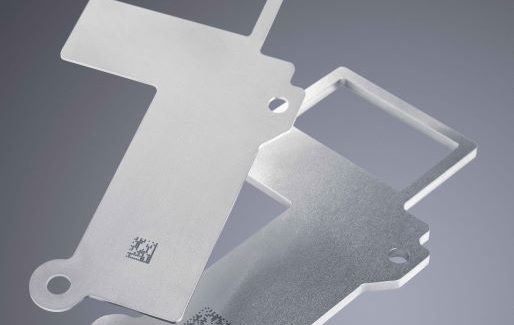Meet Dot Matrix: A Basic Tool of Industry 4.0
From the factory of origin to the final destination, dot-matrix codes can help track, trace and inform everyone in the product lifecycle. The dot-matrix code really is one of the most basic, and important, tools of Industry 4.0.
Posted: October 15, 2021
THE CUTTING EDGE
By Tom Bailey
Two-dimensional codes have been ubiquitous in our society for a long time. Decades ago, product packaging began incorporating 2D codes to allow better inventory management in retail stores. The food service and medical supply industries were using 2D codes to trace batches and ensure product quality, and shipping experts were using them to track the movement of goods all over the world.
The most common form, the bar code, worked well in many applications but also had some limitations. To encode information in the form of thicker and thinner bars arranged in one direction requires a good deal of linear space. This isn’t too cumbersome for a short ID number, but for any more substantial information the sequence of bars could become quite long. Aside from taking up space on whatever surface the bar code is affixed to, there is a practical limit to how physically large the bar code can be before standard scanning devices can no longer read it.
Another limitation of bar codes, which most of us have seen personally in operation at the local grocery store or pharmacy, is readability. Bar codes need to be completely visible, left-to-right, in order for the code scanner to read them. If the code becomes scratched, scuffed, deformed or otherwise partially defaced, it can quickly become unreadable for the scanning device. For a device intended to ensure traceability, to have information easily lost is a serious drawback. This concern, along with the desire to miniaturize increasing amounts of information, were the main drivers behind the development of the dot-matrix code. In this encoding scheme, data is arranged in two directions in parallel rows of dots, creating a pattern reminiscent of a checkerboard. By allowing the code to grow in 2-dimensions, as opposed to one for the bar code, dot-matrix codes can store more information in a physically smaller area.
ADVANTAGES FOR BOTH THE COMPANY AND THE END USER
Even more interesting in many applications is that dot-matrix codes can have built-in redundancy. In simplest terms, dot-matrix codes can be created in such a way that up to 70 percent of the encoded surface can be unreadable and the relevant data can still be recovered from the remaining code. This means that the code has the potential to survive deformation, weathering, and even deliberate defacement and remain readable. When the code is needed for tracking hardware going into critical machinery, that becomes a big advantage when it needs repair a few years down the line.
In a fabrication shop, dot-matrix codes can easily be generated and added to printed routing sheets so that team members on the factory floor can use code scanners to “clock-in” to a particular job and also verify the work instructions for the job. These can also link computer workstations on the factory floor to production prints, so that metal forming and welding operations can be checked as needed without additional paper. Adding these codes to reusable tracking devices which move with a job through the factory can also allow fabricators to eliminate the paper altogether: Now scanners connected to PC or tablet computers can scan the tracking device to display routings, work instructions, production prints and whatever other relevant information is needed to get the job done.
In the absence of dedicated tracking devices, the dot-matrix code can still help your fabrication enterprise reduce or eliminate routings. Modern fiber lasers can etch dot-matrix codes directly onto parts, and likewise the current generation of punching machines can produce dot-matrix codes mechanically via peening tools. Codes etched or engraved directly onto parts can allow routing, program selection at CNC machines, and production information to be displayed on command, just like the printed paper version. It is worth noting here, though, that scanning etched codes on grey steel requires a good quality scanning device; some lower-quality models designed for scanning printouts may not do the job.
Etched dot-matrix codes can be useful in many ways and can also be handled in many ways. These will generally disappear beneath a layer of paint or powder coating, so they can be used to route painted products through a factory and then vanish at the last step before it goes on to the end user. If paint isn’t used, the code can also be hidden on an area of a component where it won’t be seen by the end user, such as an inside or bottom face.
In some cases, it may be highly desirable to have the dot-matrix code remain visible throughout the product life cycle. Most of us have seen, and probably interacted with at some point, QR codes that are used to direct people from a sign or product package to a promotional website. Dot-matrix codes can likewise be used to provide a permanent link to a product web page, that any end-user with a smart phone can scan. If the product has a dedicated support page, or a website where accessories and spare parts are sold, it can be quite handy to have that URL etched as a small code somewhere on the product. Modern phones, upon detection of such a code via the camera, will automatically open the web browser and navigate the user to the indicated site, making it a truly seamless process for the user to access product information.
Such a code can also be used to provide quick access to troubleshooting, diagnostic and repair information for products which technicians or users are expected to perform maintenance or field servicing. This is quite handy for a ventilation technician if they are trying to find the correct parts for a broken air handling system, for example. From the factory of origin to the final destination, dot-matrix codes can help track, trace and inform everyone in the product lifecycle. They can also enhance the end-user experience, making their perception of both the product and the brand behind it improve. For all these reasons the dot-matrix code really is one of the most basic, and important, tools of Industry 4.0.
Tom Bailey is TruBend Series press brakes technical specialist for TRUMPF Inc. Email tom.bailey@us.trumpf.com.

















